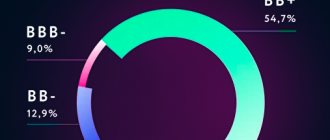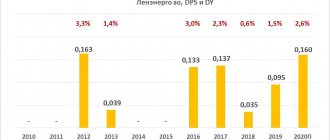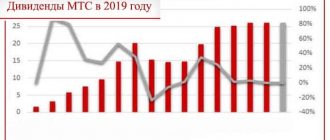2019 unexpectedly became a year of rally in the debt market: the easing of the monetary policy of the Bank of Russia was translated into a decrease in interest rates throughout the debt market, with the exception of the high-yield bonds (HYB) segment. The volume of market bond placements increased almost 1.5 times, while the share of issuers with lower credit ratings and the share of issuers without a rating in the placement structure increased. The active involvement of retail investors in investments in unrated VDO bonds is fraught with problems for both the investors themselves and the issuers of this sector. At the same time, limiting the list of instruments available for investment for unqualified investors to quotation lists 1 and 2 may jeopardize the functioning of the VDO sector in principle. The presence of an objective independent assessment of the issuer's credit risk in the form of a credit rating of any level will allow even unqualified investors to make a balanced, informed decision on investing in certain securities, comparing the risk of a single issue of VDO with other issues in the sector, as well as with issues of larger issuers.
| Philip Muradyan, Junior Director for Corporate and Sovereign Ratings, Expert RA |
| Mikhail Nikonov, leading analyst for corporate and sovereign ratings at Expert RA |
Risk Notice
To begin with, I note that further material in the text is not an investment recommendation or a guide to action. I studied the market and simply expressed my opinion.
Make your decision to invest in a particular instrument based on your own analysis and understanding of how it generally works.
Also, when indicating profitability, the trader’s possible costs – commissions, taxes, etc. – were not taken into account.
All bond prices and calculated simple yields to maturity are current as of the date the review was written.
Summary
The improved situation with the availability of debt financing makes it possible to reduce concerns about the creditworthiness of the largest and largest issuers, many of which have credit ratings. However, rating coverage for smaller companies is still low. The active involvement of unqualified investors and individuals in investing in high-yield bonds is fraught with problems for both the investors themselves and the issuers of this sector. VDO issuing companies are often opaque; making an informed decision on investing in such securities requires appropriate competence, as well as access to insider information. The unsecured nature of lending to such companies by individuals through bond issues increases the risks of unreliability. As a result, the decision to purchase a particular bond in the VDO sector is made based on the coupon rate and the reputation of the issue organizer. The lack of information for analysis leads to the fact that, to a first approximation, all issuers in the sector look the same, so the default of an individual issuer in the sector will have a negative impact on the reputation of other issuers in the sector, making it difficult for them to refinance, which, in turn, can lead to new defaults.
Currently, regulation is responding to this issue by making it more difficult for unqualified investors to access high-risk investments. Thus, in the first reading a bill was adopted, according to which unqualified investors will be able to invest exclusively in bonds 1 and 2 of the exchange’s quotation list. In order to be included in these lists, an issuer currently needs to have a credit rating on the national scale of at least “BBB+”, which virtually eliminates the possibility of VDO issuers being included in these lists. Because the bond sector is dependent primarily on retail investor demand, its performance will be compromised. In our opinion, the very fact that the issuer has a credit rating should be sufficient to protect the interests of unqualified investors. The prohibition on retail investors investing in lower rated instruments is excessive. The presence of an objective, reliable independent assessment of the issuer's credit risk allows even unqualified investors to make a balanced, informed decision on investing in certain securities, comparing the risk of a single issue of VDO with other issues in the sector, as well as with issues of larger issuers.
Source: CbondS
Rationale for choosing a tool
Why bonds, and not, say, mutual funds or the same deposits? There are several reasons:
- bonds allow you to get predictable income (naturally, if we talk about bonds with a constant coupon income);
- Broker commissions for purchasing bonds are meager – compared to mutual funds, where they can cost up to 5% per year;
- coupon income on OFZs, municipal bonds and corporate bonds issued after 2021 is not subject to income tax, therefore, the yield of these instruments, other things being equal, is higher than on those that are subject to this tax (the same mutual funds and shares);
- the bond can be easily sold, receiving the accumulated coupon income, at any time - if you want to close the deposit, you will lose the accumulated interest.
You can also buy bonds using an IIS and receive additional income - for more details, see the article on purchasing OFZs using an IIS.
In Focus: The Housing Industry
In some industries focused exclusively on the domestic market, lower interest rates can partially offset structural negative shocks. An example would be reform in the housing construction sector. From July 1, 2021, developers are prohibited from working directly with funds received under shared construction agreements, which must be deposited in escrow accounts. Previously, funds from shareholders were the main and free source of financing construction projects in Russia. Now, to finance new projects, developers have to attract project loans from banks. Financing raised against existing funds in escrow accounts is issued at a preferential interest rate, which is lower than the key rate of the Bank of Russia. In addition, to obtain project loans, developers need to invest at least 15% of their own funds in the project, which, in turn, can be financed either with their own funds, which, as a rule, only the largest developers with a large pool of projects can afford, or by attracting debt to the holding company level.
In the new mechanism, the excess of the loan drawdown over the amount of proceeds from escrow accounts leads to increased interest expenses at a “non-concessional” rate. Almost all developers began preparing for the transition in advance: accumulating liquidity on their balance sheets, taking a more conservative approach to acquiring projects that scatter capital. This instantly strengthened their credit levels, while new demands were just starting to take a toll on their finances. For large and medium-sized companies, most of the projects continue to operate according to the “old” rules with the direct attraction of money from shareholders. Thus, there is no significant stress across the entire financial system of the largest players yet. The transition to the new system will occur gradually: projects in the escrow account system should replace old projects in the portfolios of developers within a few years, so the formal entry into the coverage area of the new rules had virtually no effect on the ratings of developers. The agency has not made any downgrades or downgrades in outlook related to the impact of the escrow account reform. For individual companies, we are seeing ratings increases due to the successful implementation of their strategies.
Selection methodology
On average, banks at the beginning of 2021 offer rates of 7.5-8% per annum for annual deposits with an amount of 100 thousand rubles or more. I decided to take the upper limit of 8% as the reporting point - and looked for bonds with yields above this value.
To learn about what types of yield there are and how the coupon differs from the yield to maturity, read the link: How to calculate the yield of a bond and what types of yield there are.
Other criteria:
- permanent coupon (for all except OFZ);
- lack of depreciation (except for municipal ones, since most of them are bonds with depreciation);
- placement is carried out openly;
- fairly high liquidity - you can enter into a trade with a large volume, but still look at the prices in the order book;
- circulation period - until the end of 2021 (to be comparable to a deposit for 1-1.5 years);
- denomination – 1000 rubles.
Here’s another interesting article: How bonds are repaid
He divided bonds into three categories: OFZ, municipal and corporate. In each I chose the most liquid and least risky ones (i.e., issued by a reliable issuer with a high credit rating).
Review of rating actions by Expert RA over the past year
The decline in interest rates in the economy had a positive impact on some credit ratings of non-financial companies covered by Expert RA. The strongest effect was observed in companies with a high level of debt load. The achieved savings on interest expenses for such companies allowed them to reduce the absolute amount of debt at a faster pace, which was reflected in the corresponding debt metrics. In addition, the sheer reduction in interest expenses for companies led to more comfortable values for the EBITDA/% metric for creditors, facilitating access to refinancing and improving the debt structure. Some companies deliberately kept their loan portfolio short, hesitant to lock in expensive borrowing rates for years to come. The replacement of such loans at lower rates with longer maturities improved the companies' current debt load and their forecast liquidity, having a positive impact on the ratings.
Lower borrowing costs have had a positive impact on some companies' decisions to make capital expenditures to expand production. Some companies have a significant margin of safety in terms of the acceptable level of debt load; their investment program is extended over time or projects are characterized by short payback periods. The credit ratings of such companies have not changed. However, some companies have announced more aggressive expansion plans that have required raising additional debt financing. The average forecast debt metrics for such companies were revised upward, which negatively affected the ratings.
In export-oriented commodity industries, we observed selective increases in credit ratings, including due to the fact that companies took advantage of a period of high prices for commodities with a relatively stable ruble exchange rate and reduced their debt burden.
Government bonds
As it turned out, OFZs are not very capable. The maximum effective repayment rate turned out to be 7.46% for OFZ-24019. In a bank, with due effort, you can earn more (I mean a bank deposit, and not working as a cashier in a bank :)))
However, to do this, you still need to “freeze” money for a long period - 2-3 years - and a fairly large amount - maximum rates start with deposits generally starting from 1 million rubles. With OFZs, comparable returns can be obtained from at least one thousand rubles.
See the table for what happened. Included OFZ and COBRs in it. OFZs are available for purchase by individuals, and COBRs can only be purchased by credit institutions, but I included them for the general picture.
| Bond name | Maturity date (offer) | Number of coupon payments per year | Current coupon rate | Dirty price (with NKD) | Simple yield to maturity |
| OFZ-46018-PD | 24.11.2021 | 4 | 6,50% | 979,80 | 7,93% |
| COBR-18 | 15.05.2019 | 4 | 7,75% | 1001,80 | 7,92% |
| COBR-16 | 13.03.2019 | 4 | 7,75% | 1016,32 | 7,90% |
| OFZ-25083-PD | 15.12.2021 | 2 | 7,00% | 995,97 | 7,85% |
| OFZ-26217-PD | 18.08.2021 | 2 | 7,50% | 997,43 | 7,83% |
| COBR-17 | 17.04.2019 | 4 | 7,75% | 1009,38 | 7,74% |
| OFZ-26205-PD | 14.04.2021 | 2 | 7,60% | 1028,31 | 7,71% |
| OFZ-26214-PD | 27.05.2020 | 2 | 6,40% | 1003,49 | 7,59% |
| OFZ-29011-PK | 27.02.2019 | 2 | 8,24% | 1013,31 | 7,57% |
| OFZ-24019-PK | 16.10.2019 | 2 | 7,35% | 1026,78 | 7,46% |
Let me remind you that the selection included bonds that must be repaid by December 31, 2021. If you remove this criterion and select the longest bonds, you can find a yield higher than 8% per annum. TOP 10 in the table.
| Bond name | Maturity date (offer) | Number of coupon payments per year | Current coupon rate | Dirty price (with NKD) | Simple yield to maturity |
| OFZ-26218-PD | 17.09.2031 | 2 | 8,50% | 1047,35 | 8,50% |
| OFZ-26224-PD | 23.05.2029 | 2 | 6,90% | 919,94 | 8,48% |
| OFZ-26226-PD | 07.10.2026 | 2 | 7,95% | 1003,24 | 8,33% |
| OFZ-26212-PD | 19.01.2028 | 2 | 7,05% | 936,42 | 8,32% |
| OFZ-26207-PD | 03.02.2027 | 2 | 8,15% | 1003,64 | 8,31% |
| OFZ-26219-PD | 16.09.2026 | 2 | 7,75% | 1011,41 | 8,30% |
| OFZ-26223-PD | 28.02.2024 | 2 | 6,50% | 967,15 | 8,24% |
| OFZ-26222-PD | 16.10.2024 | 2 | 7,10% | 981,52 | 8,22% |
| OFZ-26215-PD | 16.08.2023 | 2 | 7,00% | 965,34 | 8,13% |
| OFZ-26211-PD | 25.01.2023 | 2 | 7,00% | 973,37 | 8,12% |
As you can see, the longer the maturity, the more profitable the bonds. But if the Central Bank of the Russian Federation continues to raise rates, then it is not a fact that in a couple of years these bonds will not become even cheaper.
Underwater rocks
Outwardly everything looks quite respectable. Take the declared bonds, buy in the required quantities and enjoy the income every month. In reality, everything is a little more complicated, since bonds have a finite maturity.
For example, OFZ 26207 matures on February 3, 2027, and you will not receive payments for February and August. OFZ 26219 is repaid even earlier, on September 16, 2026, and September and March are “flying out” for us.
That is, you need to monitor your portfolio and buy a new one to replace the redeemed bond.
Another pitfall is changes in the value of the bond. If the key rate goes up, the bonds will fall in price, and if you urgently need to get into the money, you will have to take a loss.
Municipal bonds
The number of municipal bonds that meet the stated criteria is much larger. Therefore, I selected the most profitable ones - with a simple yield to maturity above 8.5%. They are presented in the table.
| Bond name | Maturity date (offer) | Number of coupon payments per year | Current coupon rate | Dirty price (with NKD) | Simple yield to maturity |
| Rep. Mordovia, 34003 | 03.09.2021 | 4 | 11,7% | 1055,46 | 10,03% |
| Udmurt Republic, 35001 | 01.10.2020 | 2 | 7,45% | 253,78 | 9,2% |
| Omsk region, 35003 | 01.11.2021 | 4 | 9,3% | 1017,45 | 8,99% |
| Udmurt Republic, 34007 | 17.09.2020 | 4 | 13,8% | 980,92 | 8,91% |
| Rep. Khakassia, 35003 | 27.10.2020 | 4 | 8,4% | 400,67 | 8,86% |
| Rep. Mordovia, 34002 | 14.10.2020 | 4 | 13,75% | 639,21 | 8,72% |
| Rep. Khakassia, 35005 | 11.10.2020 | 4 | 12,25% | 626,67 | 8,71% |
| Novosibirsk region, 34017 | 03.10.2021 | 4 | 8,93% | 1018,55 | 8,66% |
| Kaliningrad region, 34001 | 17.12.2021 | 4 | 10,50% | 1069,27 | 8,6% |
| Irkutsk region, 34001 | 25.12.2021 | 4 | 9,25% | 1033,62 | 8,6% |
| Rep. Karelia, 35017 | 08.04.2020 | 4 | 12,25% | 105,44 | 8,54% |
| Rep. Komi, 35011 | 27.11.2019 | 4 | 11,10% | 104,71 | 8,51% |
| Volgograd, 34008 | 19.10.2020 | 4 | 13,63% | 634,45 | 8,50% |
And here’s another interesting article: What are bonds and how to make money on them
Once again, I would like to draw your attention to the fact that most municipal bonds are amortizing, i.e. The issuer gradually pays the face value. Therefore, for example, the Rep. bond. Khakassia, 35005 is sold for 626.67 rubles - its current face value is not 1000 rubles, but 600. Consequently, the yield to maturity of such bonds is gradually decreasing, since the issuer pays a coupon in relation to the face value. And the same 12.25% of 1000 rubles is much more than from 600 and even more so from 300.
Take this point into account.
How to assemble such a briefcase yourself
To assemble a bond portfolio to generate monthly income, you will have to sift through a lot of information - after all, you need to figure it out so that the coupon is paid every month.
However, there is a service that has already done everything for us. And when preparing this article, I used it. This is an investment service. Link: https://red-circule.com/podbor-obligaciy.
You just need to follow the link, select the necessary portfolio parameters, and the automatic assistant will generate a set of OFZs.
You can also build a portfolio of corporate bonds, but only when you subscribe. The asking price is 490 rubles per month.
Attention: this is not an advertisement; Tsirkul did not pay me a penny for this information. I just found a cool service that I share with my readers.
Now I know where I can look for OFZs that I can include in my investment portfolio to create monthly cash flow. But I advise you not to blindly follow the instructions of the service, but to study the bonds yourself and make an informed decision whether to take them or not. Good luck, and may the money be with you!
Rate this article
[Total votes: 2 Average rating: 4]
Corporate bonds
The choice among corporate bonds is undoubtedly higher. More than 200 bonds met these criteria. The record holder for yield was the bonds of FC Mercury - with a price of 190 rubles and a par value of 1000, the yield to maturity is 806.34%.
But these are discount bonds, i.e. There is no coupon for them. And in my opinion, these are big risks. Be that as it may, repayment will occur on October 28, 2021, we’ll see.
The most profitable coupon bonds are:
| Bond name | Maturity date (offer) | Number of coupon payments per year | Current coupon rate | Dirty price (with NKD) | Simple yield to maturity |
| Stroyzhilinvest-01 | 10.07.2019 | 2 | 7,85% | 914,45 | 39,89% |
| APRI Fly Planing BO-01 | 11.04.2019 | 4 | 18,00% | 1014,87 | 28,06% |
| Element Leasing BO-04 | 30.03.2021 (09.04.2019) | 4 | 0,01% | 978,02 | 26,97% |
| First collection bureau, BO-01 | 15.10.2021 | 4 | 15,00% | 950,14 | 21,95% |
| Orient Express Bank 03 | 28.05.2020 | 2 | 18,00% | 0.01 (not a typo) | 21,78% |
Breathtaking, isn't it?! Double-digit income – and even higher than 20%! However, it should be remembered that the higher the profitability, the greater the risks. For example, SamaraTransneft-Terminal with a coupon of 17.00% has already defaulted. A default on the bonds of the Municipal Investment Company with a 15% coupon cannot be ruled out. Even AgroComplex with a coupon of only 0.1% has already declared a default.
In short, you need to carefully analyze the issuer, read the statements, study ratings, analyst opinions, read reviews and forums. Only then can you make an informed decision.
If you don’t want to take too much risk, but need to get an income higher than the bank deposit, then you can choose bonds of companies that are highly likely to pay off. If not themselves, then at the expense of the state. These are state-owned enterprises, companies with a large share of state participation or “too big to fail” - the so-called “quasi-state”. I chose 15 of these.
And here’s another interesting article: Review of “eternal portfolios” TRUR, TUSD and TEUR from Tinkoff Investments
The risks of investing in them are significantly lower than in the five mentioned above, but they still exist. For example, Mechel defaulted on the 14th bond issue. Although it seems like a reliable company.
| Bond name | Maturity date (offer) | Number of coupon payments per year | Current coupon rate | Dirty price (with NKD) | Simple yield to maturity |
| Shoes BO-01 | 15.07.2020 (22.07.2019) | 2 | 15,00% | 1020,16 | 14,57% |
| Polyplast BO-03 | 05.11.2021 (15.05.2019) | 2 | 9,00% | 1021,12 | 12,37% |
| UBRIR BO-05 | 10.04.2020 (17.04.2019) | 2 | 0,10% | 982,03 | 12,00% |
| FC Otkritie BO-07 | 18.01.2021 | 2 | 0,01% | 809,61 | 11,82% |
| Hibiscus BO-03 | 16.06.2020 | 4 | 13,50% | 523,83 | 11,56% |
| Rusal Bratsk 08 | 05.04.2021 (10.04.2019) | 2 | 9,00% | 764,30 | 11,02% |
| Credit Europe Bank 001Р-02 | 09.12.2020 (16.12.2019) | 2 | 10,50% | 1002,34 | 10,59% |
| Uralvagonzavod BO-01 | 09.07.2020 (16.07.2019) | 2 | 8,75% | 1008,51 | 9,77% |
| VEB-Leasing BO-03 | 23.06.2020 | 2 | 13,09% | 1053,95 | 9,38% |
| Uralkali PBO-05-R | 09.11.2021 | 2 | 9,30% | 1030,41 | 9,35% |
| Promsvyazbank BO-08 | 28.03.2021 | 2 | 10,20% | 1054,48 | 9,20% |
| Rosselkhozbank, 10 | 29.01.2020 | 2 | 8,30% | 1001,57 | 9,04% |
| KAMAZ BO-04 | 23.11.2020 (27.11.2019) | 2 | 9,25% | 1026,47 | 9,00% |
| VEB PBO-001R012 | 21.12.2021 | 4 | 9,14% | 1030,03 | 8,85% |
| Alfa-Bank 002Р-02 | 01.11.2021 | 2 | 8,95% | 1036,12 | 8,84% |
In Focus: The Oil and Gas Contracting Industry
Over the past year, we have seen significant pressure on the ratings of oil and gas contractors, largely due to the structural nature of the sector. The oil and gas industry in Russia is characterized by a high degree of concentration: the five largest companies account for more than 75% of oil production, and three companies account for about 80% of natural gas production. Meanwhile, the oilfield services industry serving these companies is fragmented and characterized by a high level of competition. The power of the customer in this market can be expressed in the following unfavorable factors for contractors: (1) price pressure (2) deterioration of payment terms (3) increased monetary liability in emergency situations (fines / penalties). The implementation of integrated project management contracts on mining projects in conditions of limited contract margins can bring unexpected significant losses in the event of emergency situations, since the contractor in this case is responsible for the final result. This is one of the reasons why in recent years there has been a shift in the industry towards the implementation of separate service contracts at daily or meter rates, which, although they allow you to earn less, but limit the risks of liability for the project solely by the scope of work. Restrictions on oil production in accordance with the OPEC+ agreement have a restraining effect on the volume of drilling and related services, which, coupled with cost optimization programs implemented by the largest oil and gas companies, restrains the growth of contract rates for contractors and suppliers. Finally, optimization of costs for the largest customers can also influence changes for the worse in the terms of settlements under contracts, which may force contractors to attract additional loan financing to replenish working capital to the detriment of their margins. The contractor can be helped to resist these unfavorable conditions by its large scale of activity or high importance for a specific anchor customer, at least limited diversification of the contract base by customer, high technology, demand for the services provided and the absence of significant needs for modernization of fixed assets.
Statistics of rating actions Expert RA
| Increased ratings in the last 365 days | 11 |
| Downgraded ratings in the last 365 days | 7 |
| Total ratings of non-financial companies as of 11/07/2019 | 118 |
Source: Expert RA









